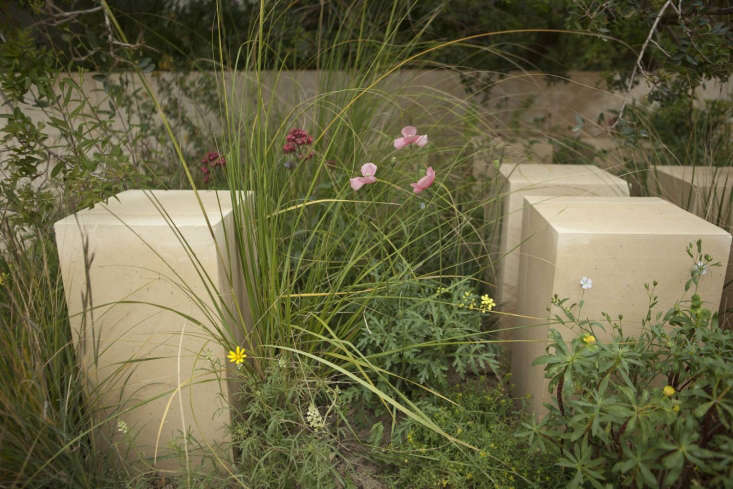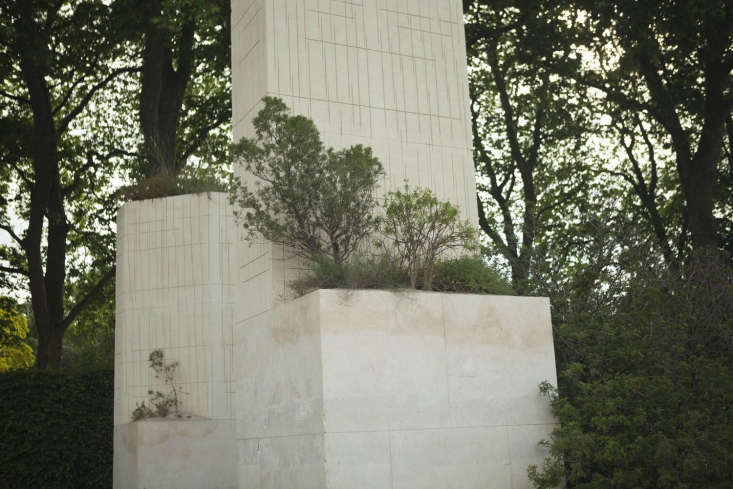The Best in Show garden at the Chelsea Flower Show this year has baffled the crowds, while pleasing the judges. According to our photographer, the place where designer James Basson’s evocation of a Maltese quarry makes the most sense is right in the middle. Demand for tickets far outstrips supply, and even then, the chance of ducking under the white rope is slim. Take this opportunity then, to enter the garden with us and see what it’s all about:
Photography by Jim Powell, for Gardenista.

People flock to the smaller gardens at the Chelsea Flower Show because they can relate to them in terms of size and concept. The Royal Horticultural Society is careful to provide “something for everyone” around the show ground but fortunately this is not the ethos behind the large show gardens. They don’t have to give visitors something to take away; instead they can give them a landscape to think about.

Between the blocks of limestone, plants that like arid places show what they can do in terms of delicate color and leaf shape. Grasses provide a green foil to dark red valerian (Centranthus ruber) and the fine pink poppy Papaver dubium subsp. lecoqii ‘Albiflorum’. In the foreground, Euphorbia melitensis, or Maltese spurge.

Abandoned, post-industrial spaces are attractive to James Basson as a designer, and a quarry in Malta became the idea behind his M&G garden. Mediterranean quarries are intensely hot at the base, while providing a series of microclimates on the various levels. Pockets of earth invite lush growth, with shaded areas between crags. Although this garden represents different growing conditions around the island, from steppes to evergreen woodland, this garden actually did remind me of an abandoned quarry garden that I know, on the Spanish island of Menorca. It feels absolutely authentic.

In this recycled garden, the table and benches are made from the planked floor of an old railway carriage. Their geometry and that of the candles strikes just the right note.




James Basson’s plant list for his best-in-show garden is phenomenally long; there is high-density diversity, next to bare paths.

This is the view of the garden, from Main Avenue, which visitors struggle with: “It looks like an abandoned holiday development,” allegedly. The geometry is quite strange but its color is a brilliant complement to the plants and the paths. Nothing is jarring, not even the weather.

The Best in Show gardens over the last couple of years have featured dramatic rock and jagged hardscaping: last year, Andy Sturgeon’s giant bronzes were inspired by the back plates of a stegosaurus; the year before, Dan Pearson brought boulders down from the Peak District. Added to the weight of his trees, the Victorian sewers underneath had to be reinforced. These tower blocks of limestone are the heaviest structures to be lifted onto a show garden: the bar has been raised.
N.B.: For more of Kendra’s coverage of Chelsea, see:
- Chelsea Flower Show 2017: Take a Bow, Charlotte Harris.
- Sneak Peek: Sights and Sounds of the 2017 Chelsea Flower Show (Opens Today).
- 8 Garden Ideas to Steal from the 2016 Chelsea Flower Show Winner.









Have a Question or Comment About This Post?
Join the conversation